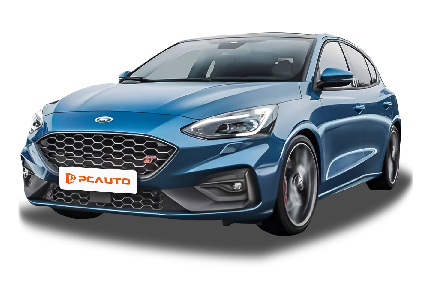Q
Is the Ford Focus ST a sport car?
The Ford Focus ST can be considered a sports car. It has a maximum speed of 248 km/h and can accelerate from 0 - 100km/h in just 6.5 seconds, which shows its strong power performance. Under the hood is a 2.0 - liter engine with 253 horsepower, providing enough power for thrilling driving experiences.
In terms of appearance, the ST usually comes with a sporty body kit, which may include features like a more aggressive front grille, side skirts, and a rear spoiler, giving it a dynamic look. The interior also has sporty touches, such as sports seats that offer better lateral support during high - speed cornering. The car is equipped with a manual transmission, which allows drivers to have more control over the driving process, adding to the sporty feel. Additionally, safety features like multiple airbags and stability control ensure that while enjoying the sporty performance, the driver and passengers are well - protected. All these aspects contribute to classifying the Ford Focus ST as a sports car.
Special Disclaimer: This content is published by users and does not represent the views or position of PCauto.
Related Q&A
Q
How many gears does a Focus ST have?
The Ford Focus ST sold in the Malaysian market comes equipped with a 2.3L EcoBoost turbocharged engine paired with a 7-speed automatic transmission with SelectShift, as opposed to a traditional dual-clutch or manual gearbox (a 6-speed manual option is available in some markets). This transmission offers flexible shifting control, allowing for manual mode engagement via steering wheel paddles, optimizing both power delivery and fuel efficiency (official figures are around 7.6L/100km).
Additionally, its performance-oriented tuning maximizes the engine's 280PS power and 420Nm torque, making it particularly well-suited for Malaysia’s winding roads and highways. It's worth noting that Ford has not introduced the latest Focus ST manual version in Malaysia, so consumers seeking pure driving enjoyment may need to consider parallel imports. Moreover, this transmission features Adaptive Shift Scheduling technology, which automatically adjusts shift logic based on driving style.
Q
Which model of Ford Focus is the most fuel-efficient ?
In terms of fuel efficiency, the three-cylinder Focus is relatively economical. It features advanced fuel injection technology and a lightweight design that enables precise control of fuel injection, promoting more complete combustion. The small displacement engine strikes a good balance between power demand and fuel consumption in urban driving conditions, and it can automatically adjust its operating mode. Additionally, the lighter body reduces the energy consumption required for the engine to drive the vehicle, with a combined fuel consumption typically ranging from 5.5L to 7.0L per 100km.
On the other hand, the 2014 Ford Focus ST 2.0 Ecoboost excels in power output efficiency. With a 2.0-liter engine that produces a maximum of 253PS, it can accelerate from 0 to 100km/h in just 6.5 seconds, showcasing outstanding performance in power delivery. However, its official combined fuel consumption stands at 7.2L/100km. Therefore, those prioritizing fuel economy might consider the three-cylinder Focus, while the ST version is more suitable for those seeking power efficiency.
Q
Does the Ford Focus ST feature AWD?
The Ford Focus ST is not AWD (All-Wheel Drive). It comes with Front Wheel Drive (FWD). This means that the power from the engine is sent directly to the front wheels. FWD is a common drivetrain layout, often chosen for its simplicity, cost-effectiveness, and decent traction in many driving conditions. The 2014 Ford Focus ST 2.0 Ecoboost with its front-wheel drive setup can provide good handling and performance on regular roads. It's important to note that while AWD can offer enhanced traction in challenging terrains like snow, mud, or on uneven surfaces, the FWD in the Focus ST is designed to optimize performance and fuel efficiency in locally normal driving scenarios.
Q
Does the Focus ST have a belt or chain?
The 2014 Ford Focus ST 2.0 Ecoboost uses a timing chain instead of a belt. Both timing chains and belts are used to drive the engine's valve train, ensuring that the intake and exhaust valves open and close at the appropriate times to allow the engine to inhale and exhale properly. However, there are differences between the two. Timing chains are more durable. Their service life usually depends on the vehicle maintenance conditions. Under normal circumstances, their lifespan can reach 100,000 kilometers or more, and they generally don't require regular replacement. On the other hand, timing belts have a relatively shorter lifespan. Typically, they need to be replaced after driving approximately 60,000 kilometers. Otherwise, it may cause the engine to malfunction. Thus, the Focus ST offers relatively straightforward maintenance for its timing system, allowing owners to avoid concerns about replacing timing belts after a certain mileage.
Q
What is the fuel efficiency of Ford Focus ST ?
2014 Ford Focus ST 2.0 EcoBoost has an official combined fuel consumption of 7.2L per 100km. Whether it's fuel-efficient depends on various factors and which model you compare it to. For a performance-oriented vehicle with 253 horsepower, this figure is relatively decent. It indicates that under normal driving conditions, it can maintain a certain level of fuel efficiency while still delivering strong acceleration capabilities.
However, if compared to some small, fuel-efficient city cars, the consumption might appear higher. Additionally, actual fuel consumption can vary significantly based on driving habits, road conditions, and vehicle load. Aggressive driving with frequent hard acceleration and braking will likely increase fuel consumption, while a more conservative and steady driving style may result in figures closer to the official data. Overall, it strikes a balance between performance and reasonable fuel consumption.
Q
How long can the engine of the Ford Focus ST last?
With proper maintenance and normal usage, the engine of the Ford Focus ST is typically expected to last over 600,000 kilometers, potentially exceeding 20 years. Ford has tested its next-generation ECOBOOST engine, which showed almost no significant signs of aging after 400,000 kilometers of operation, demonstrating impressive durability. However, the actual lifespan of the engine can be influenced by various factors.
In terms of driving habits, aggressive acceleration, hard braking, and prolonged high-load operations can increase engine wear and shorten its lifespan. Regarding component quality, using subpar engine oil, air filters, and other parts can hinder the engine's performance and longevity. Additionally, maintenance practices play a crucial role; irregular servicing and failing to timely replace oil and wear-and-tear parts can negatively impact the engine's long-term stability and operation.
Q
How big is a gas tank in Focus ST ?
The 2014 Ford Focus ST 2.0 EcoBoost features a fuel tank capacity of 55 liters. This substantial fuel storage capacity is beneficial as it allows the vehicle to achieve a notable range between fill-ups, catering to various driving needs, whether for daily commutes or long road trips. A larger fuel tank like this means fewer trips to the gas station during travels, providing added convenience for drivers. It gives you more flexibility on the road without the constant worry of running out of fuel too soon. This tank capacity is comparable to many other vehicles in its class, ensuring that the Focus ST can cover a considerable distance before needing to refuel.
Q
How reliable is Focus ST?
The Focus ST boasts a commendable level of reliability. In terms of chassis and suspension, it features dual-adjustable dampers, a double-tube stainless steel shock absorber casing, and powder-coated springs. The meticulously tuned chassis offers excellent stability, while the suspension system lowers the vehicle’s body height and can be adjusted to reduce unsprung weight, enhancing driving stability.
On the powertrain front, the equipped turbocharged 2.3-liter EcoBoost engine delivers consistent output with impressive torque characteristics. The 6-speed manual transmission offers quick and responsive shifts, providing an engaging driving experience. Inside, the cabin is well-appointed and reliable, featuring seats made from a blend of black leather and Alcantara materials, while the B&O sound system delivers an exceptional audio experience.
In terms of design, the RS-style classic Racing Blue paint job paired with high-gloss black accents creates an attractive yet durable exterior. Whether for daily commuting or more spirited driving, the Focus ST demonstrates high reliability through these outstanding attributes, giving owners worry-free driving experience.
Q
Does a Focus ST have a launch control system?
The 2014 Ford Focus ST 2.0 EcoBoost does not explicitly list a launch control system among its features. However, some other Ford Focus models have demonstrated support for a "launch assist" function in various tests. For instance, certain evaluations of the Focus revealed that the car could achieve a controlled launch. Yet, for this specific 2014 Focus ST, we cannot determine whether it is equipped with a traditional launch control system without official confirmation.
Launch control can optimize and stabilize acceleration from a standstill by precisely managing engine power, torque, and transmission engagement. While the Focus ST comes with a robust 2.0-liter engine that produces 253 horsepower and can accelerate from 0 to 100 km/h in 6.5 seconds, it likely lacks the specialized launch control feature found in some high-performance vehicles.
Q
How much horsepower can a Focus ST handle?
The horsepower that the Focus ST can withstand varies depending on the model version. For example, the 2014 Focus ST 2.0 Ecoboost has a maximum engine horsepower of 253 PS. The new Focus ST Edition special edition is equipped with an EcoBoost 2.3-liter inline 4-cylinder turbocharged gasoline engine, with a maximum output of 280 hp. Different engine tunings and technical applications result in varying horsepower performance across models. Higher horsepower delivers stronger power output, providing advantages in acceleration and overtaking. For instance, the 280-horsepower version accelerates from 0 to 100 km/h in just 5.7 seconds, with a top speed of 250 km/h, offering a more thrilling driving experience. However, during actual driving, it's essential to properly utilize the vehicle's horsepower by considering overall performance and road conditions to ensure safe operation.
Popular Cars
Model Year
Car Compare
Car Photo
Latest Q&A
Q
How much does it cost to buy a 2024 Tesla Model 3?
The 2024 Tesla Model 3 starts at around RM 175,000, but the final price depends on your chosen configuration and add-ons. Opt for the Long Range or Performance version, and you’re looking at a higher tag.
As Tesla’s entry-level model, it packs cutting-edge EV tech, including 500+ km of range on a single charge and standard Autopilot for both daily commutes and road trips. Just keep in mind extra costs like insurance, registration, and potential home charger installation.
Tesla’s Supercharger network is expanding locally, with solid coverage in major cities, making charging hassle-free. Maintenance costs? Typically lower than gas cars—no oil changes, fewer moving parts—so long-term savings add up.
If you’re after more thrills, the Performance variant hits 0-100 km/h in roughly 3 seconds. Plus, government EV tax perks help soften the upfront cost.
Q
How reliable is the 2024 Model 3?
The 2024 Model 3 delivers solid reliability, thanks to Tesla’s continuous software updates and hardware refinements. Key areas like the battery management system and Autopilot have seen multiple optimizations, leading to a noticeable drop in failure rates.
This model features a stiffer body structure and an improved suspension setup, offering a smoother ride. Upgraded interior materials also help reduce cabin rattles—a common gripe with earlier builds.
EV maintenance costs remain low (no oil changes, etc.), though it’s wise to periodically check battery health and charging components for long-term performance. For shoppers eyeing EVs, charging infrastructure and home charging options matter—thankfully, public chargers are expanding fast, making daily use more convenient.
If you frequently road-trip, planning charging stops ahead helps. While the range easily handles daily drives, a little route prep goes a long way in maximizing the experience.
Q
What is the battery range of the Tesla Model 3 2025?
The battery range of Tesla Model 3 2025 is expected to be optimized based on existing models, and specific data needs to be released officially. However, referring to the EPA range of the 2024 rear wheel drive version, which is about 438 kilometers, and the high-performance version, which is about 513 kilometers, the 2025 model may further improve, especially in terms of battery technology or energy efficiency management. For electric vehicles, the range is greatly affected by driving habits, road conditions, and climate. Air conditioning may slightly reduce the range in hot weather, but the battery thermal management system can usually maintain stable performance. In terms of charging, Model 3 supports super fast charging, which can replenish about 250 kilometers of range in about 15 minutes, while home charging stations require 6-8 hours to fully charge. Daily commuting or long-distance travel are practical enough, it is recommended to follow Tesla's official website or local showroom for the latest information.
Q
Is the 2024 Model 3 worth the price?
The 2024 Model 3 strikes an impressive balance between price and performance. Its upgraded range, more refined interior, and enhanced autonomous driving features genuinely boost its competitiveness—especially for tech-savvy, eco-conscious buyers.
Tesla optimized the battery efficiency this time around, making it suitable for both daily commutes and longer trips, while the handling stays true to the brand’s signature responsiveness. If your budget allows and you’re open to EVs, this one’s worth considering—though a test drive is wise to see if it matches your driving style.
That said, local charging access matters. While public chargers are becoming more common, home installation costs should factor into your budget. Alternatives in this price range exist, so cross-shop specs and service policies (like warranty coverage or charging network support) to make a well-rounded decision.
Q
How many miles does a 2024 Tesla Model 3 get?
The 2024 Tesla Model 3 offers varying range figures depending on configuration. The rear-wheel-drive (RWD) version delivers an EPA-estimated 272 miles (approx. 438 km), while the all-wheel-drive Long Range model pushes that to around 341 miles (roughly 549 km). Real-world range may vary slightly based on driving style, road conditions, and climate.
As a pure EV, the Model 3 achieves this efficiency thanks to its advanced battery management system and lightweight design. It also supports fast charging—at a Tesla Supercharger, you can add up to 200 km of range in about 15 minutes. Whether for daily commutes or longer trips, that’s more than enough for most drivers, especially with charging infrastructure becoming more widespread.
If you need to maximize range, tweaking your driving mode or using the car’s built-in energy optimization features can help squeeze out even more miles.
View MoreRelated News

Ford Focus is about to cease production in November and may return in 2027 in the form of an SUV.
WilliamSep 15, 2025

2025 Ford Ranger WildTrak launched, the most powerful diesel version in the Ranger lineup
MichaelAug 25, 2025

Is the Ford Ranger V6 about to enter Malaysia?
LienAug 13, 2025

Reviewing the Ford Ranger: The Dual Advantages of Rugged Appearance and Powerful Performance
Kevin WongApr 21, 2025

Ford Unveils “Simulated Manual Transmission” Patent to Reignite Driving Pleasure in Electric Vehicle
LienApr 2, 2025
View More


















Pros
Cons